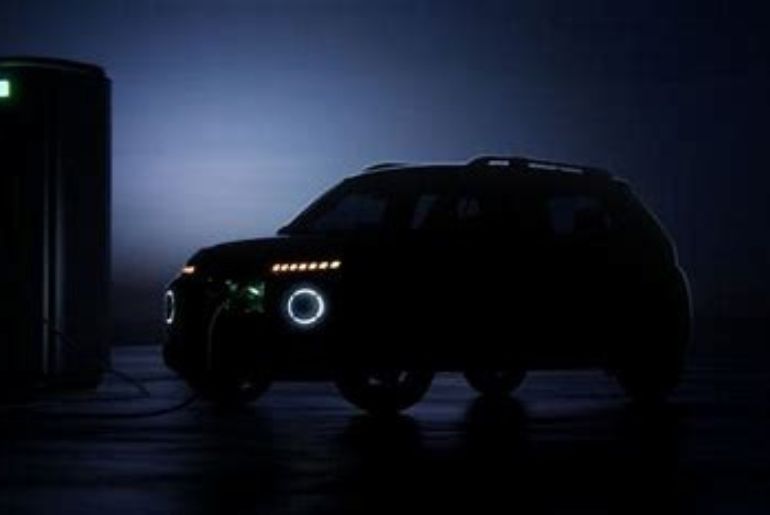In the next 12 to 24 months, Hyundai Motor India plans to aggressively compete with the domestic automaker in the volume electric vehicle industry, where Tata Motors is a formidable rival in the mainstream automotive market.
Hyundai India has been granted the green light by its Korean parent company to take on the Tata Punch EV when it launches the Creta EV into the midsize electric SUV segment in the first quarter of 2025.
The second part of 2026 is when the small SUV, codenamed HE1i, is expected to be on sale. It will have a lot in common with the Inster EV that the business debuted at the just-ended Busan Auto Show in South Korea.
With the Creta EV, Hyundai Motor India is embracing both ICE-derived electric vehicle architecture and the born-electric car platform, which is based on the widely available and reasonably priced E-GMP (K) platform (for the HE1i EV). The model will be manufactured using locally sourced Exide batteries at the company’s Sriperumbudur plant.
The Casper, which is offered in a few foreign markets, serves as the model for the Inster. The new compact SUV is 230 mm longer than the Casper, with 180 mm more added to the wheelbase to make room for a sizable battery pack. The Inster is marginally shorter than the Citroen eC3 (3,981mm) and Tata Punch EV (3,857mm) at 3,825mm.
.Two motor options have been announced in international markets – a 97hp and a 115hp, with both making 147Nm of torque. Two NMC battery packs, a Standard 42kWh and a Long-Range 49kWh are available with WLTP claimed ranges of 300km and 355km, respectively. The India-spec HE1i is also likely to get two batteries back options when it arrives.
In typical Hyundai fashion, the Inster is well equipped with features like dual 10.25-inch displays for the instrument panel and touchscreen infotainment, ADAS, auto climate control and a 360-deg camera with blind spot monitoring.
Between the Creta EV (26,000 units) and compact electric SUV (65,000 units), Hyundai Motor India is planning an annual output of about 90,000 units. However, this also includes a significant portion that’s been earmarked for exports, especially when talking about the smaller SUV.
The company has committed Rs 20,000 crore for electric vehicle development in the Indian market in the next eight years. Hyundai, in its draft hearing red prospectus (DRHP) stated that it plans to calibrate its EV strategy and timeline in-line with market demand in the country by launching appropriate models. The DRHP stated that Hyundai India will launch four new electric vehicles, including a mass-market model. Its popular Creta EV will be available at the end of the current financial year.
“We are following a transition strategy, starting with the launch of high-end, premium EVs. We plan to transition towards the mass market as the EV market and ecosystem sales increase in India. In line with this, we aim to launch four EV models in the future, including the Creta EV, in the last quarter of fiscal 2025,” the company said.
While the Creta EV and compact EV have been finalised, an EV version of its Venue compact SUV and a Grand i10 Nios-based EV are being considered.
An email sent to Hyundai Motor India did not elicit any response till time of publication of this article
The South Korean carmaker was among the first to introduce an electric vehicle in India when it launched the Kona Electric in 2019, with the Ioniq 5 following suit. However, since these were imported, the company needed more numbers. Hyundai India believes that its South Korean parent company’s diversified xEV portfolio, which includes battery EVs, hybrid EVs, plug-in hybrid EVs, mild-hybrid EVs, and fuel cell EVs, will be a “key enabler” for EV strategies in India.
“We believe that our experience in developing dedicated, localised ICE models will help us leverage their know-how to develop localised xEV models for the Indian market,” the DRHP note added.
Tata Motors sells about 75,000 EVs annually with a portfolio of four vehicles (Tiago, Tigor, Punch, and Nexon). The company is sprucing up its offerings with the new Curvv, Harrier EV and Sierra EV launch in the next 12-24 months.
Despite launching the Punch EV earlier this year, Tata Motors has experienced a slowdown in monthly volumes. While Hyundai will pose fresh competition to Tata Motors, the latter is keen on new players entering the market as it will help expand the fledgling electric vehicle market in India.
Tata Motors, a leader in the electric vehicle car space with a market share of over 75 percent, has gradually inched closer to Hyundai Motor India for the number 2 position, with just 30,000 units separating both companies. If the transition to EVs gathers momentum, a fresh battle in the EV space between Hyundai and Tata Motors may well be the differentiator in the future for the number two position in the fast growing Indian passenger vehicle market.


